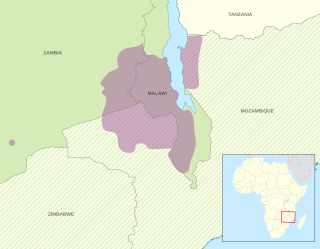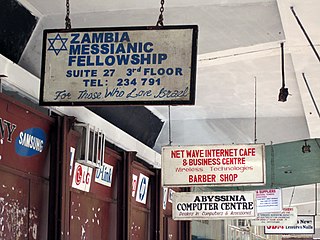Related Research Articles

The Bantu languages are a language family of about 600 languages that are spoken by the Bantu peoples of Central, Southern, Eastern and Southeast Africa. They form the largest branch of the Southern Bantoid languages.
Clement Martyn Doke was a South African linguist working mainly on African languages. Realizing that the grammatical structures of Bantu languages are quite different from those of European languages, he was one of the first African linguists of his time to abandon the Euro-centric approach to language description for a more locally grounded one. A most prolific writer, he published a string of grammars, several dictionaries, comparative work, and a history of Bantu linguistics.

Swahili, also known by its local name Kiswahili, is a Bantu language originally spoken by the Swahili people, who are found primarily in Tanzania, Kenya and Mozambique. Estimates of the number of Swahili speakers, including both native and second-language speakers, vary widely, generally ranging from 60 million to 150 million; most of its native speakers reside in Tanzania.

Zulu, or IsiZulu as an endonym, is a Southern Bantu language of the Nguni branch spoken and indigenous to Southern Africa. It is the language of the Zulu people, with about 13.56 million native speakers, who primarily inhabit the province of KwaZulu-Natal in South Africa. Zulu is the most widely spoken home language in South Africa, and it is understood by over 50% of its population. It became one of South Africa's 12 official languages in 1994.
Shona is a Bantu language of the Shona people of Zimbabwe. The term is variously used to collectively describe all the Central Shonic varieties or specifically Standard Shona, a variety codified in the mid-20th century. Using the broader term, the language is spoken by over 14,000,000 people.
The Sotho-Tswana languages are a group of closely related Bantu languages spoken in Southern Africa. The Sotho-Tswana group corresponds to the S.30 label in Guthrie's 1967–71 classification of languages in the Bantu family.

Bemba, ChiBemba, is a Bantu language spoken primarily in north-eastern Zambia by the Bemba people and as a lingua franca by about 18 related ethnic groups.

Chewa is a Bantu language spoken in Malawi and a recognised minority in Zambia and Mozambique. The noun class prefix chi- is used for languages, so the language is usually called Chichewa and Chinyanja. In Malawi, the name was officially changed from Chinyanja to Chichewa in 1968 at the insistence of President Hastings Kamuzu Banda, and this is still the name most commonly used in Malawi today. In Zambia, the language is generally known as Nyanja or Cinyanja/Chinyanja '(language) of the lake'.
Soga, or Lusoga, is a Bantu language spoken by the Soga people of the Busoga region in Eastern Uganda. With over three million speakers, it is one of the major languages of Uganda, after English, Swahili, and Luganda. However, it is largely restricted to the Busoga region, which is mainly within the natural boundaries of Lake Victoria to the south, Lake Kyoga to the north, the Nile river to the west and the Mpologoma ('Lion') river to the east of Namutumba district. It is tonal.
Tumbuka is a Bantu language which is spoken in Malawi, Zambia, and Tanzania. It is also known as Chitumbuka or Citumbuka — the chi- prefix in front of Tumbuka means "in the manner of", and is understood in this case to mean "the language of the Tumbuka people". Tumbuka belongs to the same language group as Chewa and Sena.
Ndau is a Bantu language spoken by 1,400,000 people.

Zambia has several major indigenous languages, all members of the Bantu family, as well as Khwedam, Zambian Sign Language, several immigrant languages and the pidgins Settla and Fanagalo. English is the official language and the major language of business and education.
The Mambwe and Lungu peoples living at the southern end of Lake Tanganyika in Tanzania and Zambia speak a common language with minor dialectical differences. Perhaps half of the Fipa people to their north speak it as a native language. When spoken by the Fipa, it is called "Fipa-Mambwe"; this is also the term for the branch of Bantu languages which includes Fipa and Mambwe-Lungu.
Digo (Chidigo) is a Bantu language spoken primarily along the East African coast between Mombasa and Tanga by the Digo people of Kenya and Tanzania. The ethnic Digo population has been estimated at around 360,000, the majority of whom are presumably speakers of the language. All adult speakers of Digo are bilingual in Swahili, East Africa's lingua franca. The two languages are closely related, and Digo also has much vocabulary borrowed from neighbouring Swahili dialects.
Mongo, also called Nkundo or Mongo-Nkundu, is a Bantu language spoken by several of the Mongo peoples in the Democratic Republic of the Congo. Mongo speakers reside in the north-west of the country over a large area inside the curve of the Congo River. Mongo is a tonal language.
Malawi Lomwe, known as Elhomwe, is a dialect of the Lomwe language spoken in southeastern Malawi in parts such as Mulanje and Thyolo.
Ila (Chiila) is a language of Zambia. Maho (2009) lists Lundwe (Shukulumbwe) and Sala as distinct languages most closely related to Ila. Ila is one of the languages of the Earth included on the Voyager Golden Record.
Dom is a Trans–New Guinea language of the Eastern Group of the Chimbu family, spoken in the Gumine and Sinasina Districts of Chimbu Province and in some other isolated settlements in the western highlands of Papua New Guinea.
Aushi, known by native speakers as Ikyaushi, is a Bantu language primarily spoken in the Lwapula Province of Zambia and the (Haut-)Katanga Province of the Democratic Republic of Congo. Although many scholars argue that it is a dialect of the closely related Bemba, native speakers insist that it is a distinct language. Nonetheless, speakers of both linguistic varieties enjoy extensive mutual intelligibility, particularly in the Lwapula Province.
Lamba people are a Bantu ethnolinguistic group mainly located in the Central, Copperbelt, and North-Western provinces of Zambia. Lamba people speak the Lamba language, with Lamba and Lima the major dialects recognized.
References
- ↑ Lamba at Ethnologue (18th ed., 2015) (subscription required)
- ↑ Jouni Filip Maho, 2009. New Updated Guthrie List Online
- ↑ Doke, Clement (1927). Lamba Folklore .
- ↑ Doke 1927, pp. 2-279.
- ↑ Doke 1927, pp. 283-519.
- ↑ Doke 1927, pp. 550-570.
- ↑ Doke 1927, pp. 523-545.